The high-precision confocal sensor market is projected to rise from USD 182.3 million in 2025 to USD 468.7 million by 2035, reflecting an impressive CAGR of 9.9% over the forecast period. The long-term growth trend clearly signals sustained expansion, with the market more than doubling in value over the decade. Confocal sensors are increasingly adopted for their superior accuracy in applications such as semiconductor inspection, medical imaging, precision manufacturing, and quality control. This persistent growth trajectory demonstrates that demand will not stagnate, as industries continue to require advanced sensing technology to meet stringent quality and efficiency benchmarks.
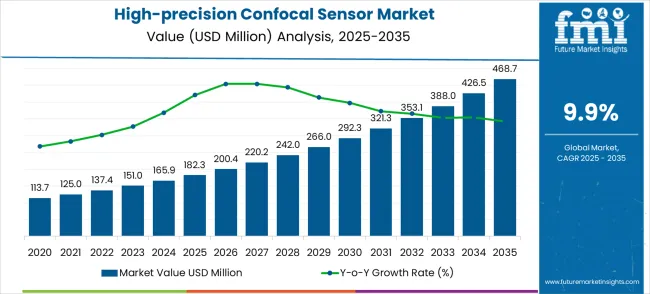
From 2025 through 2029, the market exhibits steady gains, advancing from USD 182.3 million to USD 266.0 million. Annual increments during this phase average around USD 20.9 million, highlighting consistent uptake across industrial automation and microelectronics. This period represents the early growth stage where adoption is driven primarily by the semiconductor and automotive sectors, which are increasingly deploying confocal sensors to enhance defect detection and surface profiling accuracy. The underlying trend indicates linear momentum, with each year adding progressively more value, supported by a robust pipeline of technological integration.
| Metric | Value |
|---|---|
| Estimated Value in (2025E) | USD 182.3 million |
| Forecast Value in (2035F) | USD 468.7 million |
| Forecast CAGR (2025 to 2035) | 9.9% |
The middle phase, from 2030 to 2032, shows accelerated expansion as the market surges from USD 292.3 million to USD 388.0 million. Here, average annual growth reaches approximately USD 32 million, reflecting broader penetration into advanced manufacturing and healthcare diagnostics. During this period, exponential trends are more visible as demand scales rapidly, driven by nanotechnology, 3D measurement applications, and stricter quality compliance in electronics. Polynomial trendline visualization would highlight this acceleration, showing how compounded demand creates an upward curve, with year-on-year gains growing in both scale and significance.
From 2033 to 2035, witnesses further strengthening, with the market reaching USD 468.7 million by 2035. Average annual increments of about USD 42 million during this stage highlight how the industry enters a mature yet high-growth phase. This is a strong indication that confocal sensors are transitioning from niche tools to mainstream technologies in industrial and medical ecosystems. The trajectory confirms that the market is not only growing but also accelerating over time, validating exponential or polynomial growth models as the best fit for visualization. The market thus emerges as one of the fastest-expanding sensor segments, driven by precision-demanding industries that will continue to underpin its rising market share.
Market expansion is being supported by the increasing global demand for precision measurement technologies and the corresponding shift toward advanced confocal sensing solutions that can provide superior measurement accuracy while meeting industry requirements for non-contact and high-speed dimensional inspection. Modern semiconductor and electronics manufacturers are increasingly focused on incorporating high-precision confocal sensors to enhance production quality while satisfying demands for ultra-accurate surface profiling and thickness measurement capabilities. Confocal sensors' proven ability to deliver superior measurement precision, non-contact operation, and real-time monitoring makes them essential equipment for advanced manufacturing processes and quality assurance applications.
The growing focus on automated quality control and Industry 4.0 manufacturing is driving demand for high-quality confocal sensor products that can support distinctive measurement capabilities and premium equipment positioning across semiconductor fabrication, electronics manufacturing, and precision machining categories. Equipment manufacturer preference for sensors that combine measurement excellence with advanced automation compatibility is creating opportunities for innovative confocal sensing implementations in both traditional and emerging manufacturing applications. The rising influence of smart manufacturing technologies and digital quality control is also contributing to increased adoption of premium confocal sensor products that can provide authentic high-precision measurement characteristics.
The market is segmented by sensor type, application, and region. By sensor type, the market is divided into point sensors and line sensors. Based on application, the market is categorized into semiconductors, 3C electronics, the glass industry, precision machining, battery, and others. Regionally, the market is divided into North America, Europe, East Asia, South Asia & Pacific, Latin America, and the Middle East & Africa.
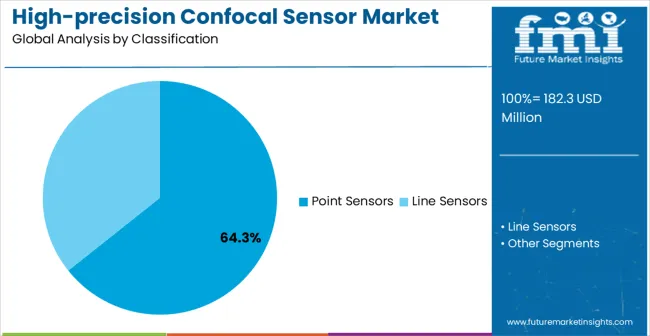
The point sensors segment is projected to account for 64.3% of the high-precision confocal sensor market in 2025, reaffirming its position as the leading sensor type category. Manufacturing equipment manufacturers and quality control specialists increasingly utilize point confocal sensors for their superior measurement precision, consistent performance characteristics, and ease of integration in automated inspection systems across diverse manufacturing applications. Point sensor technology's standardized optical configuration and focused measurement capability directly address the industrial requirements for precise spot measurements and efficient quality control in semiconductor and electronics manufacturing operations.
This sensor type segment forms the foundation of modern precision measurement applications, as it represents the technology with the greatest accuracy potential and established compatibility across multiple manufacturing inspection systems. Manufacturer investments in point sensor optimization and measurement precision enhancement continue to strengthen adoption among industrial equipment producers. With manufacturers prioritizing measurement accuracy and consistent quality control, point confocal sensors align with both precision objectives and automation requirements, making them the central component of comprehensive dimensional measurement strategies.
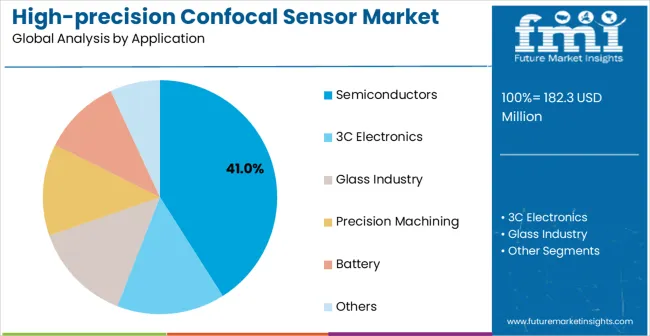
Semiconductor applications are projected to account 41.0% market share of high-precision confocal sensor demand in 2025, underscoring their critical role as the primary application for advanced measurement solutions in semiconductor fabrication and wafer processing operations. Equipment manufacturers prefer confocal sensors for their exceptional measurement accuracy, non-contact operation capabilities, and ability to maintain consistent performance while supporting precise thickness measurement requirements during semiconductor manufacturing processes. Positioned as essential equipment for high-performance semiconductor fabrication operations, confocal sensors offer both technological advancement and operational reliability advantages.
The segment is supported by continuous growth in semiconductor manufacturing activities and the growing availability of specialized sensor configurations that enable enhanced measurement precision and process optimization at the fabrication level. The semiconductor manufacturers are investing in advanced metrology technologies to support next-generation chip production and quality consistency. As semiconductor manufacturing continues to advance and manufacturers seek superior measurement automation solutions, semiconductor applications will continue to dominate the application landscape while supporting technology advancement and manufacturing precision strategies.
The high-precision confocal sensor market is advancing steadily due to increasing manufacturing automation investments and growing demand for precision measurement solutions that emphasize superior dimensional accuracy across semiconductor processing and electronics manufacturing applications. The market faces challenges, including high sensor costs compared to traditional measurement alternatives, technical complexity in optical system integration, and competition from alternative measurement technologies. Innovation in optical sensing accuracy and application-specific sensor development continues to influence market development and expansion patterns.
The growing adoption of confocal sensors in smart manufacturing and Industry 4.0 applications is enabling equipment manufacturers to develop systems that provide distinctive measurement capabilities while commanding premium positioning and enhanced precision characteristics. Advanced applications provide superior dimensional accuracy while allowing more sophisticated quality control development across various manufacturing categories and technology segments. Manufacturers are increasingly recognizing the competitive advantages of high-precision measurement positioning for premium equipment development and advanced manufacturing market penetration.
Modern confocal sensor suppliers are incorporating artificial intelligence algorithms, machine learning optimization, and predictive measurement analytics to enhance sensing accuracy, improve measurement reliability, and meet manufacturing industry demands for intelligent and adaptive quality control solutions. These programs improve sensor performance while enabling new applications, including predictive quality monitoring and automated defect detection systems. Advanced AI integration also allows suppliers to support premium market positioning and technology leadership beyond traditional commodity measurement sensors.
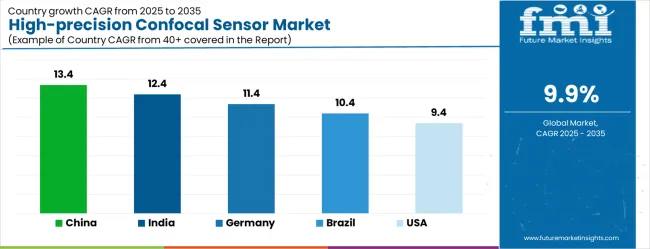
| Country | CAGR (2025-2035) |
|---|---|
| China | 13.4% |
| India | 12.4% |
| Germany | 11.4% |
| Brazil | 10.4% |
| USA | 9.4% |
| UK | 8.4% |
| Japan | 7.4% |
The market is experiencing robust growth globally, with China leading at a 13.4% CAGR through 2035, driven by the rapidly expanding semiconductor manufacturing sector, massive investments in electronics production facilities, and increasing adoption of advanced metrology technologies. India follows at 12.4%, supported by growing electronics manufacturing, rising automation investments, and expanding precision machining capabilities. Germany shows growth at 11.4%, prioritizing advanced engineering technology and premium measurement equipment manufacturing. Brazil records 10.4%, focusing on emerging industrial automation applications and manufacturing technology development. The USA demonstrates 9.4% growth, prioritizing advanced semiconductor manufacturing and precision measurement innovation. The UK exhibits 8.4% growth, supported by specialized measurement technology development and advanced manufacturing capabilities. Japan shows 7.4% growth, focusing precision manufacturing excellence and high-quality sensor production.
The report covers an in-depth analysis of 40+ countries; top-performing countries are highlighted below.
China is projected to exhibit exceptional growth with a CAGR of 13.4% through 2035, driven by the rapidly expanding semiconductor manufacturing sector and massive government investments in electronics production capabilities across major technology hubs. The country's growing semiconductor fabrication capacity and increasing adoption of advanced metrology technologies are creating substantial demand for high-precision measurement solutions in both established and emerging manufacturing applications. Major sensor technology manufacturers and measurement equipment companies are establishing comprehensive research and production capabilities to serve both domestic consumption and export markets.
India is expanding at a CAGR of 12.4%, supported by the growing electronics manufacturing industry, increasing automation investments, and expanding precision machining applications. The country's developing manufacturing ecosystem and expanding technology infrastructure are driving demand for quality confocal sensor products across both electronics assembly and industrial manufacturing applications. International sensor companies and domestic measurement technology manufacturers are establishing comprehensive distribution and assembly capabilities to address growing market demand for advanced metrology solutions.
Germany is projected to grow at a CAGR of 11.4% through 2035, driven by the country's advanced engineering technology sector, premium measurement equipment manufacturing capabilities, and leadership in precision automation solutions. Germany's sophisticated manufacturing culture and willingness to invest in high-performance measurement technologies are creating substantial demand for both standard and specialized confocal sensor varieties. Leading technology companies and measurement equipment manufacturers are establishing comprehensive innovation strategies to serve both European markets and growing international demand.
Brazil is projected to grow at a CAGR of 10.4% through 2035, supported by the country's expanding industrial automation sector, growing manufacturing applications, and increasing adoption of advanced measurement technologies requiring high-precision sensing solutions. Brazilian manufacturers and international companies consistently seek reliable confocal sensor products that enhance production quality for both domestic applications and regional markets. The country's position as a regional manufacturing hub continues to drive innovation in measurement technology applications and quality standards.
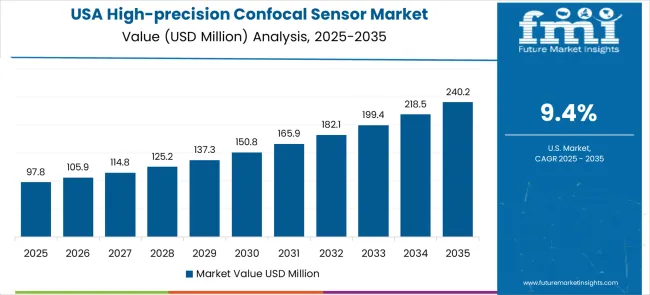
The United States is projected to grow at a CAGR of 9.4% through 2035, supported by the country's advanced semiconductor manufacturing sector, measurement technology innovation capabilities, and established leadership in high-performance metrology solutions. American semiconductor companies and equipment manufacturers prioritize precision, reliability, and technical excellence, making confocal sensors essential equipment for both domestic production and technology-oriented manufacturing. The country's comprehensive research capabilities and technical expertise support continued market development.
The United Kingdom is projected to grow at a CAGR of 8.4% through 2035, supported by the country's specialized measurement technology development sector, advanced manufacturing capabilities, and established expertise in high-performance sensing solutions. British manufacturers' focus on innovation, precision, and technical excellence creates steady demand for premium confocal sensor equipment. The country's attention to measurement accuracy and application optimization drives consistent adoption across both traditional manufacturing and emerging precision applications.
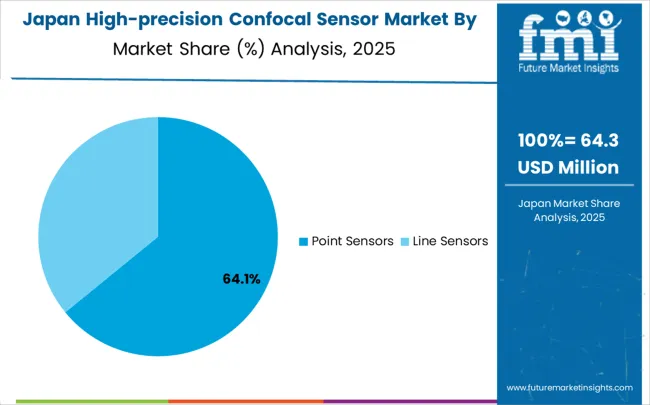
Japan is projected to grow at a CAGR of 7.4% through 2035, supported by the country's precision manufacturing excellence, advanced sensor technology expertise, and established reputation for producing superior measurement equipment while working to enhance optical sensing capabilities and develop next-generation confocal technologies. Japan's sensor industry continues to benefit from its reputation for delivering high-quality measurement products while focusing on innovation and manufacturing precision.
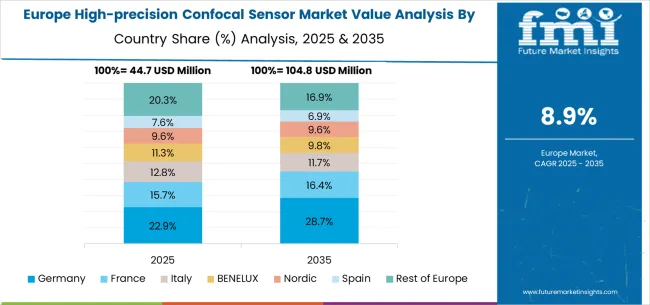
The high-precision confocal sensor market in Europe is projected to grow from USD 46.8 million in 2025 to USD 108.4 million by 2035, registering a CAGR of 8.7% over the forecast period. Germany is expected to maintain its leadership position with a 38.6% market share in 2025, remaining stable at 38.4% by 2035, supported by its advanced engineering technology sector, precision measurement equipment manufacturing industry, and comprehensive innovation capabilities serving European and international markets.
The United Kingdom follows with a 24.7% share in 2025, projected to reach 25.1% by 2035, driven by specialized measurement technology development programs, advanced manufacturing capabilities, and a growing focus on high-precision sensing solutions for premium applications. France holds a 16.8% share in 2025, expected to maintain 16.6% by 2035, supported by advanced manufacturing demand and precision technology applications, but facing challenges from market competition and economic considerations. Italy commands an 11.2% share in 2025, projected to reach 11.4% by 2035, while Spain accounts for 5.9% in 2025, expected to reach 6.1% by 2035. The Netherlands maintains a 2.8% share in 2025, growing to 2.9% by 2035. The Rest of Europe region, including Nordic countries, Eastern Europe, Belgium, Switzerland, and Austria, is anticipated to hold 15.7% in 2025, declining slightly to 15.4% by 2035, attributed to mixed growth patterns with moderate expansion in some advanced manufacturing markets balanced by slower growth in smaller countries implementing precision measurement development programs.
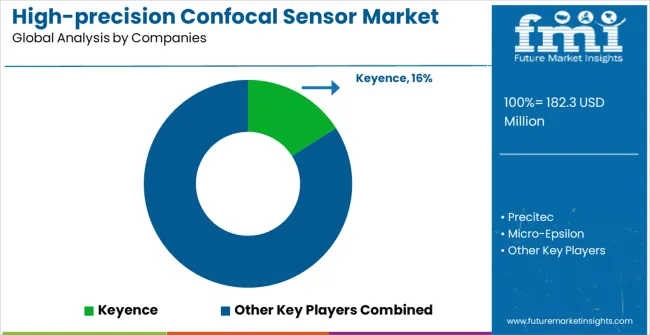
The market is characterized by competition among established sensor technology companies, specialized measurement equipment manufacturers, and integrated metrology solution suppliers. Companies are investing in advanced optical sensing technologies, measurement precision enhancement systems, application-specific sensor development, and comprehensive technical support capabilities to deliver consistent, high-performance, and reliable confocal sensing products. Innovation in measurement accuracy optimization, sensing range enhancement, and customized application solutions is central to strengthening market position and customer satisfaction.
Keyence leads the market with a strong focus on advanced sensor technology innovation and comprehensive automation solutions, offering sophisticated confocal sensor products with focus on measurement precision and industrial integration excellence. Precitec provides specialized laser measurement capabilities with a focus on precision applications and global manufacturing networks. Micro-Epsilon delivers advanced displacement and dimension measurement technology with a focus on innovation and premium sensor development. LMI Technologies specializes in 3D scanning and measurement solutions with focus on technical expertise and application optimization. STIL focuses on optical metrology and confocal sensing technologies. SICK emphasizes industrial sensor expertise with a focus on automation integration and operational reliability.
High-precision confocal sensors represent advanced optical measurement technology that enables non-contact, ultra-accurate dimensional inspection and surface profiling critical for modern manufacturing quality control. With the market projected to grow from USD 182.3 million in 2025 to USD 468.7 million by 2035 at a 9.9% CAGR, these sensors address the increasing demands for precision measurement in semiconductor fabrication, electronics manufacturing, and automated quality control systems. The dominance of point sensors (64.3% market share) and semiconductor applications reflects the technology's critical role in enabling advanced manufacturing processes where traditional contact measurement methods cannot achieve the required accuracy or speed. The market expansion faces challenges including high sensor costs, complex optical system integration requirements, and competition from alternative measurement technologies. Maximizing growth potential requires coordinated efforts across sensor technology developers and manufacturers, precision manufacturing industries and quality control specialists, automation system integrators and metrology service providers, research institutions and standards organizations, and technology investment and commercialization partners.
How Sensor Technology Developers and Manufacturers Could Drive Innovation Leadership?
Advanced Optical Technology Development: Invest in next-generation confocal sensing technologies, including enhanced optical designs, improved laser systems, and advanced signal processing algorithms that provide superior measurement accuracy, extended sensing range, and faster measurement speeds. Develop sensor platforms that push the boundaries of precision measurement while maintaining reliability under industrial operating conditions.
Application-Specific Sensor Solutions: Create specialized confocal sensor configurations optimized for specific industries, including semiconductor wafer inspection, electronics component measurement, glass thickness monitoring, and precision machining quality control. Develop sensors with application-specific features such as high-temperature compatibility, cleanroom certification, and specialized measurement ranges.
AI-Enhanced Measurement Capabilities: Integrate artificial intelligence and machine learning algorithms into confocal sensor systems to enable adaptive measurement optimization, predictive maintenance, and intelligent data analysis. Develop smart sensors that can automatically adjust measurement parameters, detect anomalies, and provide actionable insights for quality control optimization.
Cost-Performance Optimization: Focus on manufacturing process improvements and design innovations that reduce sensor costs while maintaining measurement accuracy and reliability. Develop scalable production methods that enable broader market adoption without compromising the precision characteristics that define confocal sensor technology.
System Integration and Connectivity: Create confocal sensors with comprehensive connectivity options, including Industry 4.0 compatibility, cloud integration, and seamless data sharing capabilities. Develop sensors that integrate easily with existing manufacturing systems and provide real-time measurement data for immediate quality control decisions.
How Precision Manufacturing Industries Could Optimize Measurement Systems?
Quality Control System Integration: Implement comprehensive quality management systems that leverage confocal sensor capabilities, including statistical process control, real-time monitoring, and automated decision-making. Develop measurement protocols that maximize the value of high-precision sensing while ensuring consistent product quality and regulatory compliance.
Process Optimization and Automation: Integrate confocal sensors into automated manufacturing lines to enable real-time quality control, dimensional verification, and process adjustment. Develop closed-loop systems that use sensor feedback to optimize manufacturing parameters and maintain consistent product quality automatically.
Measurement Data Analytics: Establish comprehensive data analysis capabilities that transform raw sensor measurements into actionable manufacturing insights, including trend analysis, predictive quality modeling, and process improvement recommendations. Use measurement data to optimize production processes and prevent quality issues before they occur.
Cross-Industry Knowledge Sharing: Collaborate across different manufacturing sectors to share best practices for confocal sensor implementation, measurement techniques, and quality control strategies. Participate in industry forums and technical associations that advance measurement technology adoption and standardization.
Return on Investment Demonstration: Develop comprehensive ROI models that quantify the benefits of high-precision confocal sensors, including reduced scrap rates, improved product quality, enhanced productivity, and competitive differentiation. Document case studies and success stories that demonstrate tangible value from precision measurement investments.
How Automation System Integrators and Metrology Service Providers Could Enable Market Growth?
Turnkey Measurement Solutions: Provide complete measurement system integration services, including sensor selection, system design, software development, installation, and commissioning. Develop standardized integration methodologies that reduce implementation complexity and accelerate deployment of confocal sensing solutions.
Calibration and Validation Services: Establish specialized calibration laboratories and validation services that ensure confocal sensor accuracy and traceability to international standards. Provide ongoing calibration maintenance, system verification, and measurement uncertainty analysis that supports customer quality systems and regulatory compliance.
Training and Technical Support: Deliver comprehensive training programs covering confocal sensor theory, operation, maintenance, and troubleshooting. Develop certification programs for measurement technicians and provide ongoing technical support that ensures optimal sensor performance and measurement reliability.
Application Engineering: Provide specialized application engineering services that help customers optimize confocal sensor implementations for specific measurement challenges. Develop custom measurement solutions, fixture designs, and software configurations that maximize sensor performance for unique applications.
Remote Monitoring and Support: Implement advanced remote monitoring capabilities that provide predictive maintenance, performance optimization, and immediate technical support. Develop service platforms that enable proactive sensor maintenance and minimize measurement system downtime.
How Research Institutions and Standards Organizations Could Support Technology Advancement?
Fundamental Research Programs: Conduct advanced research in confocal sensing technology, including novel optical designs, improved measurement algorithms, and enhanced sensor performance characteristics. Support collaborative research programs between universities and industry that address current technology limitations and enable breakthrough innovations.
Measurement Standards Development: Establish comprehensive measurement standards and calibration procedures for confocal sensors, including accuracy specifications, test methods, and traceability requirements. Develop international standards that ensure measurement consistency and enable global technology adoption.
Technology Transfer and Commercialization: Bridge the gap between research developments and commercial applications by providing technology validation services, prototype testing, and commercialization support. Facilitate partnerships between research institutions and industry to accelerate technology transfer and market adoption.
Educational Programs: Develop specialized education programs in optical metrology and confocal sensing technology, including university courses, professional training, and technical certification programs. Train the next generation of measurement specialists and support workforce development for precision manufacturing industries.
International Collaboration: Foster international cooperation in confocal sensing research, standards development, and technology advancement. Organize technical conferences, workshops, and collaborative research programs that advance the global state of measurement science and technology.
How Technology Investment and Commercialization Partners Could Unlock Market Value?
Innovation Investment: Fund breakthrough research and development programs in confocal sensing technology, including novel optical approaches, advanced signal processing, and next-generation measurement capabilities. Support startups and established companies developing disruptive measurement technologies that address current market limitations.
Market Development Capital: Finance market development activities, including demonstration projects, application development programs, and technical education initiatives that accelerate confocal sensor adoption in emerging applications and geographic markets. Support expansion into high-growth markets like China (13.4% CAGR) and India (12.4% CAGR).
Manufacturing Scale-Up Investment: Provide capital for advanced manufacturing facilities, precision optical equipment, and quality control systems that enable cost-effective production of confocal sensors at commercial scale. Support the development of manufacturing processes that maintain optical precision while achieving competitive costs.
Strategic Partnership Facilitation: Support partnerships between sensor manufacturers, automation companies, and end-user industries that accelerate technology commercialization and market adoption. Facilitate joint development programs that address specific market needs and create comprehensive measurement solutions.
Global Market Expansion: Fund international business development, including the establishment of regional technical centers, distribution networks, and customer support capabilities. Support market entry strategies that leverage local partnerships and address regional measurement requirements and standards.
| Items | Values |
|---|---|
| Quantitative Units (2025) | USD 182.3 million |
| Sensor Type | Point Sensors, Line Sensors |
| Application | Semiconductors, 3C Electronics, Glass Industry, Precision Machining, Battery, Others |
| Regions Covered | North America, Europe, East Asia, South Asia & Pacific, Latin America, Middle East & Africa |
| Countries Covered | United States, Canada, United Kingdom, Germany, France, China, Japan, South Korea, India, Brazil, Australia and 40+ countries |
| Key Companies Profiled | Keyence, Precitec, Micro-Epsilon, LMI Technologies, STIL, SICK, OMRON, Hypersen, LightE, Pomeas, SinceVision, THINKFOCUS, Acuity Laser, Proldv, and Tronsight |
| Additional Attributes | Dollar sales by sensor type and application, regional demand trends, competitive landscape, technological advancements in optical sensing, precision measurement development initiatives, accuracy optimization programs, and manufacturing integration enhancement strategies |
The global semiconductor grade carbon fiber rigid felts market is estimated to be valued at USD 60.7 million in 2025.
The market size for the semiconductor grade carbon fiber rigid felts market is projected to reach USD 133.6 million by 2035.
The semiconductor grade carbon fiber rigid felts market is expected to grow at a 8.2% CAGR between 2025 and 2035.
The key product types in semiconductor grade carbon fiber rigid felts market are pan based, pitch based and rayon based.
In terms of application, crystal growth equipment segment to command 50.0% share in the semiconductor grade carbon fiber rigid felts market in 2025.






Our Research Products

The "Full Research Suite" delivers actionable market intel, deep dives on markets or technologies, so clients act faster, cut risk, and unlock growth.

The Leaderboard benchmarks and ranks top vendors, classifying them as Established Leaders, Leading Challengers, or Disruptors & Challengers.

Locates where complements amplify value and substitutes erode it, forecasting net impact by horizon

We deliver granular, decision-grade intel: market sizing, 5-year forecasts, pricing, adoption, usage, revenue, and operational KPIs—plus competitor tracking, regulation, and value chains—across 60 countries broadly.

Spot the shifts before they hit your P&L. We track inflection points, adoption curves, pricing moves, and ecosystem plays to show where demand is heading, why it is changing, and what to do next across high-growth markets and disruptive tech

Real-time reads of user behavior. We track shifting priorities, perceptions of today’s and next-gen services, and provider experience, then pace how fast tech moves from trial to adoption, blending buyer, consumer, and channel inputs with social signals (#WhySwitch, #UX).

Partner with our analyst team to build a custom report designed around your business priorities. From analysing market trends to assessing competitors or crafting bespoke datasets, we tailor insights to your needs.
Supplier Intelligence
Discovery & Profiling
Capacity & Footprint
Performance & Risk
Compliance & Governance
Commercial Readiness
Who Supplies Whom
Scorecards & Shortlists
Playbooks & Docs
Category Intelligence
Definition & Scope
Demand & Use Cases
Cost Drivers
Market Structure
Supply Chain Map
Trade & Policy
Operating Norms
Deliverables
Buyer Intelligence
Account Basics
Spend & Scope
Procurement Model
Vendor Requirements
Terms & Policies
Entry Strategy
Pain Points & Triggers
Outputs
Pricing Analysis
Benchmarks
Trends
Should-Cost
Indexation
Landed Cost
Commercial Terms
Deliverables
Brand Analysis
Positioning & Value Prop
Share & Presence
Customer Evidence
Go-to-Market
Digital & Reputation
Compliance & Trust
KPIs & Gaps
Outputs
Full Research Suite comprises of:
Market outlook & trends analysis
Interviews & case studies
Strategic recommendations
Vendor profiles & capabilities analysis
5-year forecasts
8 regions and 60+ country-level data splits
Market segment data splits
12 months of continuous data updates
DELIVERED AS:
PDF EXCEL ONLINE
Sensor Data Analytics Market Size and Share Forecast Outlook 2025 to 2035
Sensor Testing Market Forecast Outlook 2025 to 2035
Sensor Fusion Market Size and Share Forecast Outlook 2025 to 2035
Sensor Based Glucose Measuring Systems Market Size and Share Forecast Outlook 2025 to 2035
Sensor Development Kit Market Size and Share Forecast Outlook 2025 to 2035
Sensory Modifier Market Size and Share Forecast Outlook 2025 to 2035
Sensor Bearings Market Insights - Growth & Forecast 2025 to 2035
Sensor Hub Market Analysis - Growth, Demand & Forecast 2025 to 2035
Sensor Patches Market Analysis - Growth, Applications & Outlook 2025 to 2035
Sensors Market Analysis by Type, Technology, End User & Region - Forecast from 2025 to 2035
Sensor Cable Market
Sensormatic Labels Market
3D Sensor Market Size and Share Forecast Outlook 2025 to 2035
Biosensors Market Trends – Growth & Future Outlook 2025 to 2035
UV Sensors Market Analysis by Type, End User, and Region from 2025 to 2035
CP Sensor for Consumer Applications Market – Growth & Forecast 2025 to 2035
Nanosensors Market Size and Share Forecast Outlook 2025 to 2035
NOx Sensor Market Size and Share Forecast Outlook 2025 to 2035
VOC Sensors and Monitors Market Analysis - Size, Growth, and Forecast 2025 to 2035
Rain Sensors Market Size and Share Forecast Outlook 2025 to 2035

Thank you!
You will receive an email from our Business Development Manager. Please be sure to check your SPAM/JUNK folder too.
Chat With
MaRIA